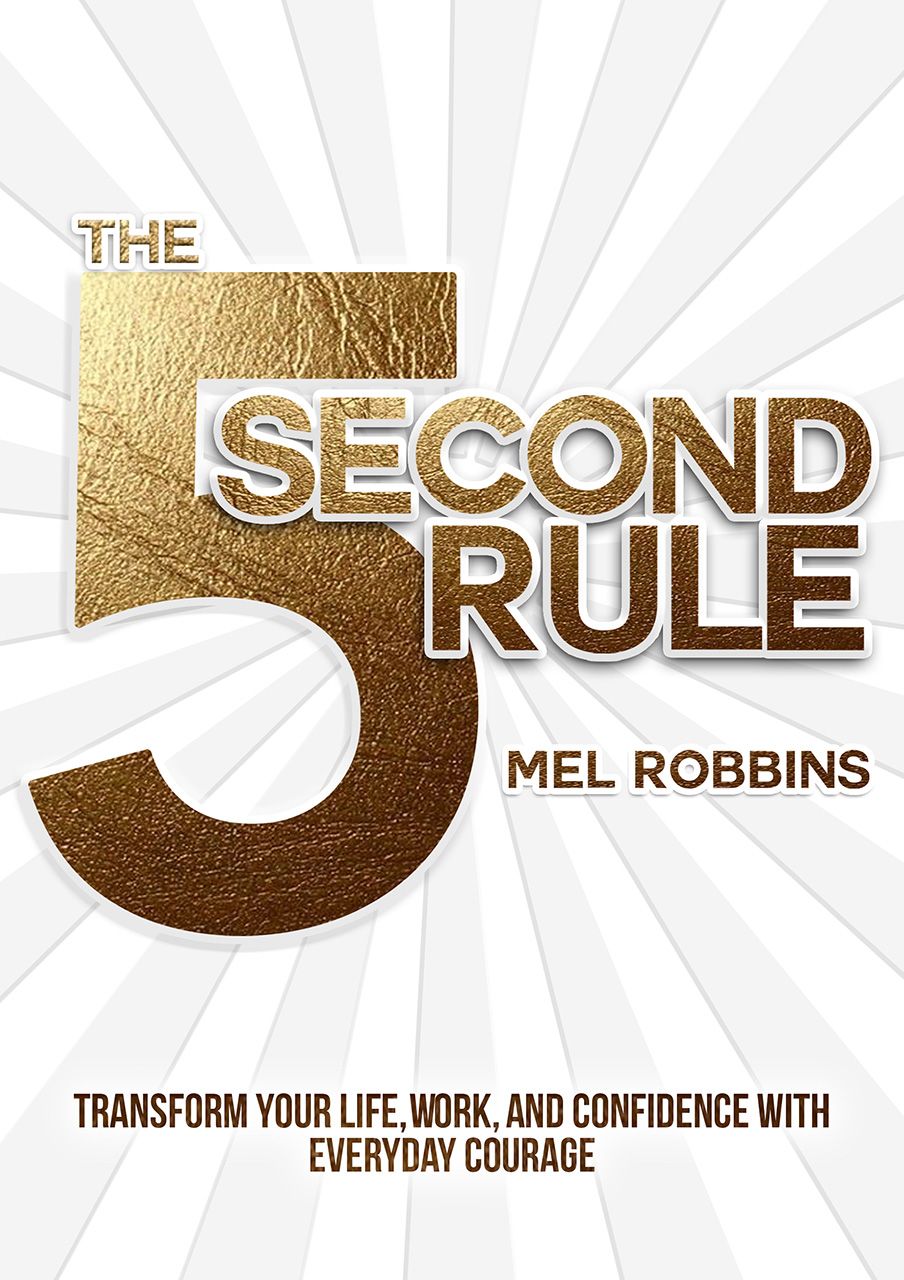"The 5 Second Rule" by Mel Robbins - Find Courage and Transform Your Life
Learning how to take control of your mind and break the pattern of overthinking can seem like a gargantuan task. If you're struggling with this, read on learn from Mel Robbins's advice and real-life examples in her book that can help you unlock your full potential.

Almost all of us have used counting as a psychological trick to get ourselves to do something. Maybe you’ve counted to three before jumping off the diving board at the pool, or tried counting sheep to calm ourselves enough to fall asleep at night. The main reason these tactics work is that they help us focus on what we need to do and cut out all the surrounding noise and consequences we don’t like to consider.
Mel Robbins's "The 5 Second Rule" has been widely read as an empowering and transformative book that offers a simple yet effective technique to overcome self-doubt, hesitation, and procrastination. By counting down from five and taking immediate action, you can break free from the limitations holding you back and create positive changes in your life.
If you're looking to take steps toward self-improvement, live in the moment, or overcome procrastination, read on to find out more about the science behind the 5 second rule and how it can help you build courage to live life on your own terms.
The Power of the 5 Second Rule

"You can't control how you feel, but you can always control how you act."
Published in 2017, Mel Robbins's book focuses on the idea of using a simple technique, the “5-second rule,” to overcome procrastination and take action towards one’s goals. The central concept of the book is the 5 second rule itself. By counting down from five and taking immediate action, you can interrupt negative thought patterns, overcome fear, and prevent overthinking. This simple rule helps you seize opportunities and make decisions that align with your goals.
The reasons why this simple idea of a 5-second countdown can do this for anyone are that through little acts of courage, the 5 second rsecule makes you less afraid over time. There is also never the “right time” for what you want to embark on, so you just have to start. The "5 Second Rule" also helps you override your feelings, and it serves as a psychological intervention.
How to Use "The 5 Second Rule" to Find Courage
1. Act Before your Brain Sabotages you
Photo by Sammie Chaffin / Unsplash
Our brains are wired to protect us and often hold us back from taking risks or stepping out of our comfort zones. By using the 5 second rule and counting, you can bypass the hesitation and self-doubt that your brain generates, allowing you to take action and achieve your desired outcomes.
“If you have an impulse to act on a goal, you must physically move within 5 seconds or your brain will kill the idea.”
Counting backwards initiates a mental shift and disrupts your habitual thought patterns, allowing you to assert control over your actions. This process, known as "assert control" in psychology, diverts your attention from making excuses and redirects it towards a new course of action. When you physically move forward instead of contemplating, your body's response changes, aligning your mind with your intentions. According to habit research terminology, the 5-second rule serves as a "starting ritual" that triggers the prefrontal cortex, a brain region responsible for focus, change, and intentional behavior. By engaging this part of the brain, the rule facilitates behavior modification and empowers you to take deliberate actions.
2. Understand The Cue-Routine-Reward Formula
Photo by Anne Nygård / Unsplash
The "cue-routine-reward" loop explains how our brains process habits. It is crucial to understand this concept for the 5-second rule to be effective. The loop consists of three parts:
- Cue: This is the trigger that initiates a behavior, such as a feeling, event, time, or location.
- Routine: This is the action or behavior that occurs in response to the cue, which can be physical, mental, or emotional.
- Reward: This is the positive outcome that reinforces the behavior, such as a tangible reward or a sense of accomplishment.
The cue-routine-reward loop forms a feedback mechanism that helps the brain learn and strengthen habits. Each time the brain identifies a cue and performs the associated routine, it receives a rewarding outcome. Repeating this loop enhances the strength of the habit over time.
3. Build Self-confidence and Resilience
The "5 Second Rule" helps you build self-confidence by encouraging you to. face your fears head-on. As you consistently push yourself outside your comfort zone, you'll develop resilience and strengthen your belief in your abilities, ultimately leading to personal growth. You can apply the 5-second rule to multiple situations, to help yourself find the courage to go through with the actions or decisions that you need to take such as:
- Speaking out loud in a meeting
- Raising your hand in class
- Volunteering to go first
- Getting to the gym
- Saying “no”
- Asking for help
Many people are unaware that patterns of thinking, such as worrying, self-doubt, and fear, are actually habits. These thought patterns are repeated unconsciously and without awareness. But from each small act of courage, more courage follows. It compounds and hopefully, when you’re old, you can look back on a courageous life.
Photo by Luemen Rutkowski / Unsplash
Following each small act of courage, take some time to reflect on how taking those actions or making those decisions made you feel. When you reflect on your actions and decisions, you develop resilience, allows you to learn from failures and setbacks, understand our strengths and weaknesses, and find ways to bounce back from challenges.
If you're looking for a place to reflect, Journey might be the all-encompassing journaling tool that you need. If you're someone who doesn't like writing in a physical notebook, or if you feel like you would leave a physical notebook lying around, this digital diary app could be the perfect solution. With Journey, you can also journal on any device you prefer — your laptop, your tablet or your phone.

Whether the way home from work after a meeting that you spoke up at, or after school and from a presentation that you aced, you can find a pocket of 10 minutes to journal about how it made you feel conveniently. Start incorporating the habit of scribing into their morning routine and start your day with a sense of clarity and purpose, setting the stage for a productive and fulfilling day.
4. Use Feelings as Suggestions Instead
To comprehend why we frequently find ourselves waiting and depending on our emotions solely to tell us what to do, Robbins turns to the research of esteemed neuroscientist Antonio Damasio, as presented in his book "Descartes' Error." Damasio's findings indicate that up to 95% of our decisions are influenced by emotions rather than objective facts, leading him to describe us as "feeling machines that think" rather than "thinking machines that feel."
Photo by Marek Studzinski / Unsplash
In essence, the typical sequence of events is not thinking followed by action; it is feeling followed by action. Consequently, the primary reason for our inaction is often that we simply "don't feel like it." To address this issue, Mel suggests drawing inspiration from professional athletes. These individuals view their feelings as suggestions rather than absolutes, enabling them to override their emotions—for instance, using the 5-second rule—and push themselves closer to their goals. If you have ever thought that you couldn't run, swim, or cycle any further, yet persevered regardless, you understand that this is indeed possible.
This process can be seen as a form of psychological intervention on a small scale. By altering our behavior to influence our emotions, rather than waiting for the reverse to occur, we can initiate positive change.
5. Don't Bank on Motivation
The idea that you need to feel eager or motivated to make changes does not always ring true. When it's time to take action, motivation is unlikely to be present, and you may not feel inclined to do anything at all. To improve your life, you need to get up and push yourself.
The "5 Second Rule" is empowering because it transforms you into someone who takes action without hesitation. If you tend to overthink, this rule provides the energy and confidence to stop overthinking and start doing. By using the rule, you strengthen your belief that you can control your life and own destiny, as you prove it to yourself with each small step. The rule doesn't make things easy; it makes things happen, and that's why it is referred to as a tool.
6. The "Right Time" Will Never Come, So Start Now
There are 2 undeniable truths that Robbins covers in her book. Firstly, we all aspire to change our lives in some way, and secondly, we tend to spend a significant portion of our time waiting for that change to magically happen. Our default excuse is consistently the same: "I'm waiting for the perfect moment." However, deep down, we know that this elusive moment will never arrive. Mel Robbins sheds light on the reasons behind this phenomenon, identifying three key factors; change is always accompanied by novelty, it inevitably brings uncertainty, and it invariably triggers fear.
Regardless of whether you wish to change or embark on, these three elements persistently manifest themselves. They remain true tomorrow, next week, and even six months from now. Embracing something new, such as signing up for a gym membership, does not guarantee a $10,000 windfall from a side gig. Likewise, attending a blind date will always evoke nervousness.
Whatever it is that you desire but lack, achieving it will always entail engaging in new, frightening, and unpredictable actions. Consequently, delaying even for a single day is nothing more than an excuse and a squandering of time. And this is precisely why the "5 Second Rule" can become your most valuable ally. Even if the initial step you take is minuscule, like conducting a Google search or setting a reminder on your phone, it remains an action, and that is the sole aspect that truly matters.
7. Be Present and Engage in the Moment
The "5 Second Rule" is not only about taking action but also about being fully present in the moment. By focusing on the present and avoiding distractions, you can make better decisions, improve your relationships, and savor life's experiences.

Use the 5 second rule in various aspects of life: The book demonstrates how the 5 second rule can be applied to different areas of life, such as career, relationships, health, and personal development. Whether it's overcoming procrastination, boosting productivity, or making positive changes, the rule can be adapted to suit your specific goals and challenges.
In her book, Mel Robbins provides practical advice and real-life examples throughout the book, inspiring readers to take immediate action and unlock their full potential. In essence, the "5 Second Rule" that she suggests is simply a countdown to taking action. But the simple action of counting down has been proven to help people to take control of your mind and breaking the pattern of overthinking and self-doubt. It also helps in transforming bad habits into good ones and taking back control of their lives.
By incorporating the "5 Second Rule" into your daily life, you can break free from self-limiting behaviors, increase your motivation, and create lasting change.







